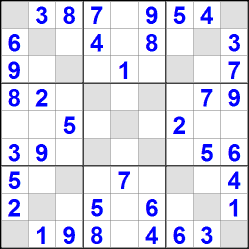 Sample starting board for Diagonal Sudoku with clues in blue.
Sample starting board for Diagonal Sudoku with clues in blue.
At the start of the game some squares will already contain digits, known as "clues" or "givens." The player must place digits in the empty squares so that each column, each row, each region (marked with thick borders) and each of the two long diagonals (marked with gray squares) contains exactly one each of the digits 1 through 9.
To enter a digit into a square, first point at the square with the mouse cursor. Then you may either type the desired digit key on the computer keyboard, or click the left mouse button and choose a digit from the popup menu that appears on the screen.
To clear a square where you have previously placed a digit, first point at the square with the mouse cursor. Then either press the space bar on the computer keyboard, or click the left mouse button and choose the 'x' symbol from the popup menu that appears.
You may also enter what is known as a "pencil mark." This is a small mark to indicate a possible value for a square but one that is not definite. Each square can have up to eight pencil marks. Pencil marks do not count toward the solution of the puzzle, they are merely conveniences for keeping track of various possibilities as you work.
To enter a pencil mark, first place the mouse cursor in the desired square. Then either press SHIFT plus the desired digit key on the computer keyboard (e.g. SHIFT+4 or "$" if you want to pencil in a "4"), or click the right mouse button and choose the desired digit from the popup menu. If your mouse only has a single button, hold down SHIFT or CTRL while clicking and then choose the desired digit from the popup menu.
Note that you can only alter the squares which were originally empty at the start of the game; the squares containing the clues (shown in blue) will remain permanent.
If you try to enter an illegal digit (one that conflicts with a matching digit already present in the same row, column, diagonal, or region) the digit will be erased and the conflicting digit(s) will briefly flash red to alert you to the mistake.
If you place a digit that completes a row, column, diagonal, or region, the sucessfully completed area will briefly flash green to signal your progress.
Once all squares have been filled, the puzzle is completed and the timer will stop. Note that because of the automatic error-checking, there is no way to "cheat" by filling in squares arbitrarily. If you are able to place the last digit, you have found the one and only solution to the puzzle!
Difficulty Settings
The difficulty of a particular Sudoku board can be roughly divided into two components: the techniques required to deduce square values, and the number of clues provided at the start of the game.
The "Technique Difficulty" setting is an expression of what strategies must be employed to complete the puzzle. The simplest techniques (Level 1) involve only direct eliminations along rows, columns, and regions. Higher level techniques must consider multiple areas simulaneously, utilize partially solved squares, etc. The highest recommended Technique Difficulty is 5. Level 6 is included as a custom option for the truly brave of heart -- unlike the lower levels, it sometimes requires guessing/testing/backtracking in order to find a workable solution.
The "Clue Difficulty" setting is straightforward. The lower the setting the more clues are provided, thus making the puzzle easier to solve. It is recommended that newcomers to Sudoku experiment with raising the Clue Difficulty first before raising the Technique Difficulty, and to set the Clue Difficulty back to 1 when first trying a new Technique Difficulty level.
<< Back to Game Page